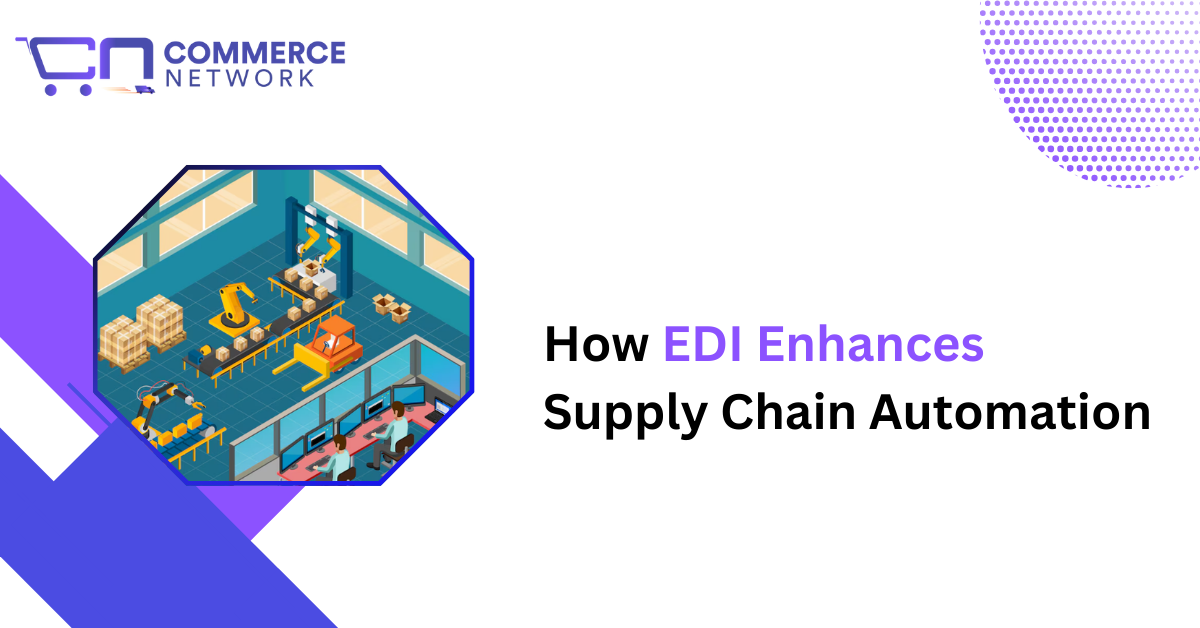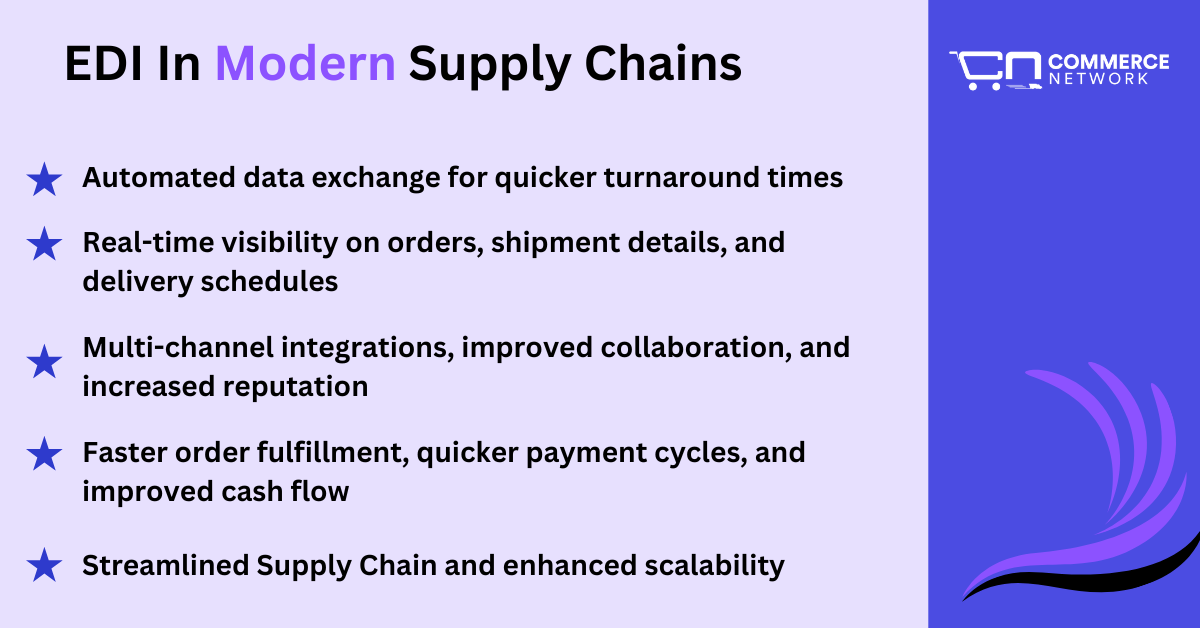
Key Takeways:
EDI speeds up order processing, shipping, and invoicing automatically.
It reduces errors by automating document exchange and tracking.
EDI helps track orders, inventory, and deliveries in real-time for better decisions.
It syncs data across multiple sales channels like eCommerce and marketplaces.
EDI automates contract, procurement, and reporting processes for government compliance.
Supply Chain Automation, now more than ever, emphasizes efficiency. In a complex supply chain network of tens of suppliers, hundreds of retailers, and thousands of customers, sending and receiving business documents like purchase orders or invoices is a massive process.
Using manual labor for document exchange in such a supply chain environment not only makes the exchange process time-consuming, costly, error-ridden, and inefficient but also significantly impacts automation efforts.
In such a context, EDI (Electronic Data Interchange) has evolved as an outstanding component that serves as a foundation as well as a catalyst for streamlined and automated supply chain operations.
EDI means Electronic Data Interchange. It involves sending and receiving data electronically, automatically, between computer systems in a set format.
With EDI, your computer system generates a document, translates it into a standardized, machine-recognizable EDI format, and transfers the document to a receiving computer which then translates the document back into a human-readable format, all without manual intervention.
Businesses automating the supply chain require a fast, reliable, and automatic transmission of data and information.
EDI acts as a companion to automation by providing a standardized communication method for electronic document exchange.
A retailer requiring certain products from a supplier can use EDI to send a Purchase Order (EDI 850), get real-time insight into its delivery through Advance Shipping Notice (EDI 856), and process financial transactions through an Invoice (EDI 810).
All the EDI transactions happen quickly and automatically, making it ideal for automated supply chain operations.
EDI has become an indispensable component in modern supply chain management. With the global integration of suppliers, retailers, distributors, manufacturers, and consumers across a multitude of industries, managing supply chain operations has become increasingly complex.
Using digital technologies does help automate the supply chain; however, without a foundation to stand on, process digitization is significantly impacted.
For example, a business owner in Africa may not understand what a manufacturer in China is saying and what a customer in America wants.
Using traditional methods like email for exchanging documents like purchase orders and invoices between these three parties is simply incomprehensible.
Using EDI on the other hand significantly reduces manual processes, increasing efficiency and streamlining the supply chain. EDI acts as a foundational technology for digital supply chain transformation.
EDI lays the groundwork for advanced technologies like AI, machine learning, and IoT by digitizing paper-based processes.
Here is how EDI helps with modern supply chain operations.

B2B supply chain automation requires instant document transmission between two or more trading partners in a supply chain network. EDI streamlines this B2B transmission process in the following ways.
EDI enables faster order fulfillment, enhanced efficiency, and streamlined procurement by allowing faster communication between vendors, enabling automatic data transfer while reducing costs and saving time.
Managing product catalogs, and sending and receiving purchase orders, shipping notices, and invoices becomes extremely easy with EDI.
This impacts the entire procurement process as vendors can easily communicate, track the orders in real-time, resolve any issues promptly, and improve procurement efficiency.
From the initial order to the final delivery, the time taken in B2B transactions matters as more and more customers want their orders delivered fast and without any issues.
EDI reduces lead time by enhancing automatic document exchange, providing real-time visibility into orders, helping resolve issues before they have any impact, and improving communication,
Here is how EDI improves accuracy and reduces lead time for the complete order cycle.
Order Processing: The order entry, verification, and approval take a short time as documents like purchase orders are automatically sent and received between computers.
Production Time: EDI facilitates real-time data exchange between different departments involved in the production process, making the production process smooth and quick.
Order Fulfillment: EDI helps manage inventory, accounting, and product delivery while reducing errors and saving time with a fast communication and collaboration environment.
Shipping Time: Advance Shipping Notices (EDI 856) help track shipping location, delivery time, shipping schedule, and more, helping improve accuracy for B2B transactions.
EDI enables businesses to meet the changing demands of customers including speed, efficiency, and quality control in the digital age.
Modern supply chain automation for Business to Consumer (B2C) transactions can benefit through EDI by:
EDI ensures seamless integration of data across multiple sales channels like websites, marketplaces, and social media platforms.
For example: Orders from Amazon, Walmart, and a business's eCommerce storefront can be synchronized and managed in a unified SaaS EDI system.
EDI automates payment processing, invoicing, and refunds to ensure smooth financial transactions.
Example: A payment gateway processes transactions securely and sends automated invoices to customers upon successful payment through EDI 810.
A business can use real-time data provided by EDI with data analytics and AI to predict consumer demand and automate inventory replenishment.
EDI automates the entire order lifecycle, from order placement to confirmation, processing, and fulfillment.
Example: When a consumer places an order on an eCommerce website, the EDI-integrated automated supply chain system automatically processes the payment, verifies inventory availability, and routes the order for fulfillment.
Tracking inventory levels in real-time and synchronizing stock data across multiple sales channels is efficient with EDI.
Example: EDI-integrated automated inventory systems integrations update stock levels instantly after a sale, ensuring accurate availability across physical stores, online platforms, and marketplaces.
EDI can be integrated with Warehouse Management Systems (WMS) to streamline picking, packing, and shipping processes through robotics and barcoding,
Example: The WMS system gets an EDI purchase order and a robotic arm in a warehouse picks items from shelves and delivers them to packing stations for faster order fulfillment.
EDI automates the selection of carriers, generation of shipping labels, and tracking of deliveries with proper delivery of shipping notices.
Delivery and shipping schedules through Advance Shipping Notices (EDI 856) keep consumers informed through automated updates on order confirmation, shipping status, and delivery timelines.
Integrating EDI in an automated supply chain simplifies the return process by automating return requests, generating shipping labels, and restocking inventory.
Example: A customer initiates a return online, receives a pre-paid label, and the system automatically updates stock availability upon getting the EDI 810 invoice receipt of the returned product.

Government procurement and order fulfillment involve a complex process with high compliance requirements, fast delivery, contract management, product catalog updates, federal marketplace integrations, and more.
Government contractors can leverage EDI in the following aspects of B2G supply chain automation:
EDI facilitates the exchange of documents related to contract creation, updates, renewals, and performance reporting.
Example: A supplier submits a contract renewal proposal to a government agency through EDI. The agency reviews and sends back an acknowledgment (EDI 997), ensuring the process is traceable and efficient.
EDI ensures that procurement documents are automatically formatted to meet government standards like FAR or specific agency protocols.
Example: A business sends an EDI 850 (Purchase Order) formatted to comply with federal guidelines, ensuring the order is processed without manual adjustments or errors.
The exchange of purchase orders, acknowledgments, and shipping details can be automated with EDI to streamline order fulfillment.
Example: A government agency places an order for office supplies through an EDI 850. The vendor’s system automatically processes the order, generates an acknowledgment (EDI 855), and confirms shipment (EDI 856).
EDI simplifies vendor registration by automating the submission of required credentials and certifications.
Example: A vendor registers on SAM.gov, submitting an EDI 810 (Invoice) to validate their tax ID and payment setup during onboarding.
EDI automates the submission of compliance reports and audit trails, ensuring traceability and adherence to regulations.
Example: A government contractor can prepare audit documents with real-time and historical EDI data on orders, invoices, and more.
Using EDI ensures smooth communication with various government platforms like GSA Advantage or FedMall through standard EDI formats.
Example: A supplier’s EDI system can integrate with FedMall to automatically update product catalogs and process orders (EDI 850) from multiple agencies.
If you are a business owner new to EDI, you need to take a structured approach for the smooth integration of EDI in your automated supply chain system.
Here are some steps you can follow to get started integrating EDI for an automated supply chain.
1. Assess Your Business Needs: Identify key areas where EDI can add value, such as order processing, vendor management, or compliance.
2. Choose the Right Partner: Select an EDI provider with expertise in your industry and robust support services.
3. Plan the Integration: Work closely with IT teams to map out the integration process, ensuring compatibility with existing systems.
4. Train Your Team: Equip employees with the knowledge and tools to leverage EDI effectively.
5. Monitor and Optimize: Continuously evaluate the performance of your EDI system, making adjustments to meet evolving needs.
Commerce Network provides a comprehensive SaaS EDI platform that comes with integration with multiple well-established suppliers, full compliance management, and a complete solution for many different industries.
Improve Your B2B, B2G, and B2C Ecommerce?
Integrate EDI For Efficiency, Compliance, and Scalability?
Just Curious About EDI?
Give Us A Call
202-280-7060